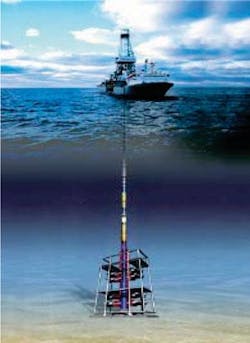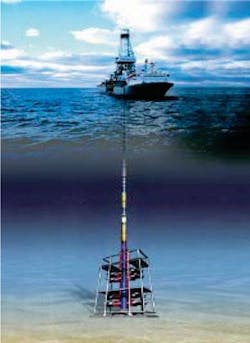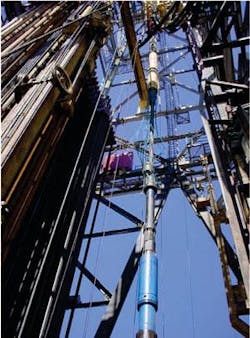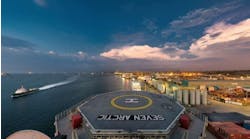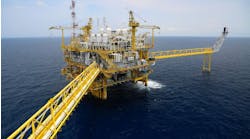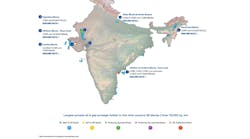Alan J. Dick
Leon Marcella
Expro International Group PLC
Control system reliability is critical for safety valve operation when companies conduct deepwater interventions. Consequently, the emerging operational demand for subsea safety systems to operate at critical stages while on high-cost deepwater well field developments has necessitated the introduction of increasingly sophisticated control systems that retain simplicity and redundancy for optimal well control.
Today, subsea safety systems deliver critical well control functions in challenging oilfield production conditions. According to the Expro Group, this technology is based on over 20 years of deepwater well testing experience that has resulted in meeting industry standards and demands.
The industry has developed landing string and controls systems to minimize risk in subsea completion and intervention operations to secure the well in the event of an emergency. The systems are compatible with all horizontal subsea christmas trees for use in water depths of up to 10,000 ft with over 500 operations around the world.
Additionally, this industry has developed a range of large-bore subsea intervention tools, or landing strings, for well operations with horizontal subsea christmas tree architecture. These tools provide well control functions and disconnection capabilities during well installation, work over, intervention, and well test operations. The landing string is a critical component in the protection and safety of personnel, the well, and the rig. The landing string also provides the capability for safe, low-cost well re-entry for future well intervention and workover.
Starting with the 10-year-old hydraulically piloted downhole accumulator system or the deepwater vent pack, the controls technology has progressed through the addition of an electro-hydraulic interface enabling the field to function in water depths to 10,000 ft. The original 3-in. bore version was introduced into the Gulf of Mexico during a drill stem test in 2002 after earlier application runs in West Africa. The latest 7-in. bore variant was first deployed in 2003.
Landing string technology
The industry has developed landing string technology that uses a high integrity ball valve system that enables the landing strings to provide “cut and seal” ability in a single device. The ball valve can be run in harsh conditions associated with the flowing or pumping of aggressively abrasive fluids from or into the well. The intervention string can provide a dual barrier required during workover operations on horizontal subsea christmas trees over a live well.
One of the primary components of a landing string is the lubricator valve that enables long intervention tool strings to be made up or recovered from the live well. The operators deploy these valves at the required depths resulting in reduced rig time during well intervention work.
A second component is the retainer valve that closes prior to unlatching the subsea landing string from the vertical subsea christmas tree. This prevents any hydrocarbons in the landing string from escaping into the environment (marine riser or onto the drill floor). This valve functions in an automatic, pre-defined logical sequence, with the emergency disconnect facility for enhanced system safety.
A third component is the subsea test tree that allows for safe operations on a live well during well test or completion operations. Dual ball valves provide primary well control barriers. A latch within the assembly provides the means to disconnect and reconnect the landing string, leaving the closed-in valve section in place. Again, the valve sequencing is automated with the emergency disconnect facility.
Landing string controls
Subsea production wells have to be controlled safely, reliably and economically, especially when operating in deepwater conditions where cost increases in proportion to water depths. Subsea control systems are designed to meet current industry emergency shutdown and emergency quick connect requirements.
In extreme conditions, conventional hydraulic systems have significant response time constraints, so an electro-hydraulic control system for additional response, functional flexibility, and electrical communication for high-speed primary control was developed. Field-proven in the GoM and West Africa, it has achieved rapid response times that meet and exceed the industry emergency disconnect requirements for well closures and disconnects. The modular design of this control system allows it to be adapted to a wide range of applications and subsea test tree configurations. Fully adaptable to 3-in., 5-in., or 7-in. bore landing strings, this system can provide hydraulic and electrical control and monitoring of subsea valves and completion equipment. The system can operate tubing-head rotary table (THRT) and tubing hanger functions, and in addition has a separate control system module, which uses multiplexed data feedback of pressures and temperatures to confirm downhole tool functions and well performance.
Development and qualification
The development of this technology occurred simultaneously with the drafting, consultation, and implementation of new standards that could easily have resulted in additional challenges through stringent new certification and testing. Use of an R&D process that is continuously improving and learning has enabled the engineering development team to match the technical and operational capabilities of the controls system with progressing standards. The testing program ran from May 2002 through to January 2003, with the main elements of the qualification program being API 16D, 17D, contaminated fluid, and installation/handling tests.
The qualification program demonstrated the performance of the control system throughout its operational envelope. Prior to first field deployment, the electro-hydraulic control system was deployed on a land rig, in order to identify any potential installation or handling issues. This test included handling the system onto the rig floor, a full functional test of the subsea test tree (SSTT) and THRT in the rotary and deploying the equipment to a water depth of 200 ft. This handling test identified areas for improvement that were subsequently implemented.
Application
The Pioneer Natural Resources Falcon Field was discovered in April 2001 on East Breaks blocks 579/623 in the westernGoM. The water depth at the discovery well was 3,450 ft. The Tomahawk discovery in 2003 followed the Raptor discovery of a month earlier. Pioneer agreed that the Tomahawk well will be the first field application of the large-bore (7-in.) control system and its associated landing string.
With emphasis on this being a fast-paced development, it was imperative from the very beginning that this technology had a tightly defined “window of opportunity” and that its operational success was expected to be delivered without the associated impact this often has on rig time when innovative new products are first introduced into the field.
The operation was performed with real-time data acquired throughout completing the well, flowing, and clean-up. On completion of the job, the landing string was recovered, enabling the well to be brought into production. In addition to the job’s success, this first field application also provided learning that was immediately captured and fed back to the design team.
Learning points
Operational efficiencies of rig-up and rig-down speed, while initially impacted by a very short job mobilization time and the practicality of efficiently managing the rig-up, were the direct result of trained field operatives and comprehensive client liaison and pre-planning. This aspect is usually more acute with the introduction of a new system, to both field personnel and the rig crew. Pre-job training and system awareness at the system integration test (SIT) stage or earlier enabled issues to be identified and resolved in advance, saving time on the job.
Field operations fed back the simplification of system make-up and the handling of assemblies in “live” conditions from field operations to the design team.
Pioneer achieved significant cost and time savings during the subsea well completion stages of the Falcon Corridor’s development and attributed this to the drilling and completions teams’ performance in conjunction with its key suppliers. The field performance indicator report verifies the success of the first operation, with a 100% rating and an “excellent subsea performance” comment.
Enhancements and opportunities
The pace of development of this technology has continued in alignment with the relevant increase in the number of major deepwater developments, especially in West Africa andGoM. The significant challenge has been to increase the operational specification required to meet the emerging market need for a high pressure (15,000 psi) electro-hydraulic control system and landing string.
The continuing development of this system focuses on reliability from design through actual application, simplicity to optimize operations/maintenance, safety system redundancy, and surface handling. The latest generation of this equipment has established a benchmark for the deepwater control of the highly reliable ball valve system of emergency well control, even with coiled tubing or wireline in the well. Landing strings are a viable option for well control during deepwater completion and intervention operations, yielding a cost-effective solution to the ever-increasing technical demands of the industry.•
Editors Note:This is a summary of the OTC 17694 paper presented at the 2005 Offshore Technology Conference held in Houston in May.
